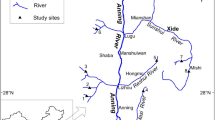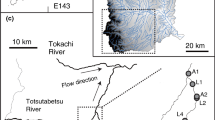Abstract
The seasonal change in gut contents of nymphs of Isoperla grammatica and I. difformis from six streams in southern Sweden was analysed. Both species had ingested a variety of benthic prey and vegetable matter, predominantly diatoms. Some seasonality was evident with high percentages of diatoms in spring in I. grammatica, and in autumn in I. difformis. The scope of food was larger in the latter species which contained about equal proportions of vegetable matter, chironomids, mayfly, stonefly, and black fly larvae. In I. grammatica plant matter and chironomids dominated strongly, comprising > 50% of the gut contents on an annual basis, > 90 % in spring. While small nymphs of I. difformis contained a low proportion of animal matter, only gradually increasing with size, the nymphs of I. grammatica were carnivorous from very early instars. Both species switched to a temporarily strong utilization of algae in spring. This differed among sites, and appeared to reflect differences in insolation and thus the availability of algae. There was a significant negative relationship between the mean densities of Isoperla nymphs and the proportion of animal material found in the guts of I. grammatica (R 2 = 0.86). Considering the density of I. grammatica alone, the relationship was weaker (R 2 = 0.56). A positive correlation between predator and prey size was observed. With chironomid prey the size range increased with predator size. With simuliid prey, however, prey size increased with predator size in such a way that it suggests selection rather than just an expanding prey size range. Correlations were stronger and regression coefficients significantly higher for I. grammatica than for I. difformis. We suggest that I. grammatica, which ingests a much wider size range of prey might choose prey of optimal sizes more readily than the more synchronously developing I. difformis. Although the life cycles of the two species are staggered, overlap in size distribution indicates that competition for food could be important in spring. However, observed differences in diet should facilitate coexistence. Gut content differences might in turn be accomplished through microhabitat segregation.
Similar content being viewed by others
References
Allan, J. D., 1982. Feeding habits and prey consumption of three setipalpian stoneflies (Plecoptera) in a mountain stream. Ecology 63: 26–34.
Allan, J. D., 1983. Food consumption by trout and stoneflies in a Rocky Mountain stream, with comparison to prey standing crop. In Dynamics of lotic ecosystems S. M. Bartell & T. D. Fontaine (eds), Ann Arbor Sci. Publ., Ann Arbor, 371–390.
Allan, J. D., A. S. Flecker & N. L. Clintock, 1987a. Prey size selection by carnivorous stoneflies. Limnol. Oceanogr. 32: 864–872.
Allan, J. D., A. S. Flecker & N. L. Clintock, 1987b. Prey preference of stoneflies: sedentary vs mobile prey. Oikos 49: 323–331.
Anderson, N. H. & K. W. Cummins, 1979. Influences of diet on life histories of aquatic insects. J. Fish. Res. Bd Can. 36: 335–342.
Bpyaekken, T., 1981. Growth patterns and food habits of Baetis rhodani. Capniapygmaea and Diura nanseni in a West Norwegian river. Holarct. Ecol. 4: 139–144.
Bailey, N. T. J., 1959. Statistical methods in biology. English Univ. Press, London.
Berthelemy, C. & M. Lahoud, 1981. Regimes alimentaires et pieces buccales de quelques Perlodidae and Perlidae des Pyrenees [Plecoptera]. Annls Limnol. 17: 1–24.
Brinck, P., 1949. Studies on Swedish stoneflies. Opusc. Ent. Suppl. 11: 1–250.
Coleman, M. J. & H. B. N. Hynes, 1970. The vertical distribution of the invertebrate fauna in the bed of a stream. Limnol. Oceanogr. 15: 31–40.
Ernst, M. R. & K. W. Stewart, 1986. Microdistribution of eight stonefly species (Plecoptera) in relation to organic matter in an Ozark foothill stream. Aquatic Insects 8: 237–254.
Feminella, J. W. & K. W. Stewart, 1986. Diet and production by three leaf-associated stoneflies (Plecoptera) in an Arkansan mountain stream. Freshwat. Biol. 16: 521–538.
Fuller, R. L. & K. W. Stewart, 1977. The food habits of stoneflies (Plecoptera) in the Upper Gunnison River, Colorado. Envir. Ent. 6: 293–302.
Grant, P. R. & R. J. Mackay, 1969. Ecological segregation of systematically related stream insects. Can. J. Zool. 47: 691–694.
Hart, D. D., 1981. Foraging and resource patchiness: field experiments with a grazing stream insect. Oikos 37: 46–52.
Hynes, H. B. N., 1941. The taxonomy and ecology of the nymphs of British Plecoptera with notes on the adults and eggs. Trans. r. Ent. Soc. 91: 459–557.
Hynes, H. B. N., 1970. The ecology of running waters. Univ. of Toronto Press, Toronto.
Jop, K. & W. Szczytko, 1984. Life cycle and production of Isoperla signata (Banks) in a central Wisconsin trout stream. Aquatic Insects 6: 81–100.
Lamberti, G. A. & V. H. Resh, 1983. Stream periphyton and insect herbivores: an experimental study of grazing by a caddisfly population. Ecology 64: 1124–1135.
Lavandier, P., 1982. Developpement larvaire — regime alimentaire, production d'Isoperla viridinervis Pictet (Plecoptera, Perlodidae) dans un torrent froid de haut montagne. Annls Limnol. 18: 301–318.
Levins, R., 1968. Evolution in a changing environment: Some theoretical explorations. Princeton Univ. Press, Princeton.
Lillehammer, A., 1985. The coexistence of stoneflies in a mountain lake outlet biotope. Aquatic Insects 7: 173–187.
MacArthur, R. H. & R. Levins, 1967. The limiting similarity, convergence, and divergence of coexisting species. Am. Nat. 101: 377–385.
Mackereth, J. C., 1957. Notes on the Plecoptera from a stony stream. J. Anim. Ecol. 26: 343–351.
Malmqvist, B., in press. Stonefly functional responses: influence of substrate heterogeneity and predator interaction. Verh. Int. Ver. Limnol. 24.
Malmqvist, B. & P. Sjöström, 1980. Prey size and feeding patterns in Dinocras cephalotes (Plecoptera). Oikos 35: 311–316.
Malmqvist, B. & P. Sjöström, 1984. The microdistribution of some lotic insect predators in relation to their prey and to abiotic factors. Freshwat. Biol. 14: 649–656.
Malmqvist, B. & P. Sjöström, 1989. The life cycle and growth of isoperla grammatica and I. difformis (Plecoptera) in southernmost Sweden: intra- and interspecific considerations. Hydrobiologia 175: 97–108.
Minshall, G. W. & N. Minshall, 1966. Notes on the life history and ecology of Isoperla clio (Newman) and Isogenus decisus Walker (Plecoptera: Perlodidae). Am. Midl. Nat. 76: 340–350.
Peckarsky, B. L., 1984. Predator-prey interactions among aquatic insects. InThe ecology of aquatic insects, V. H. Resh & D. M. Rosenberg (eds), Praeger Publ., New York.
Peckarsky, B. L. & M. A. Penton, 1985. Is predaceous stonefly behavior affected by competition? Ecology 66: 1718–1728.
Schoener, T. W., 1968. The Anolis lizards of Bimini: Resource partitioning in a complex fauna. Ecology 49: 704–726.
Shapas, T. J. & W. L. Hilsenhoff, 1976. Feeding habits of Wisconsin's predominant lotic Plecoptera, Ephemeroptera, and Trichoptera. Gt Lakes Ent. 9: 175–188.
Sheldon, A. L., 1969. Size relationships of Acroneuria californica (Perlidae, Plecoptera) and its prey. Hydrobiologia 34: 85–94.
Sheldon, A. L., 1972. Comparative ecology of Arcynopteryx and Diura (Plecoptera) in a California stream. Arch. Hydrobiol. 69: 521–546.
Sheldon, A. L.,1980. Coexistence of perlidstoneflies (Plecoptera): predictions from multivariate morphometrics. Hydrobiologia 71: 99–105.
Siegfried, C. A. & A. W. Knight, 1976. Prey selection by a setipalpian stonefly nymph, Acroneuria (Calineuria) californica Banks (Plecoptera: Perlidae). Ecology 57: 603–608.
Sjöström, P., 1983. Hunting, spacing and antipredatory behaviour in nymphs of Dinocras cephalotes (Plecoptera). Ph. D. thesis, Univ. of Lund, Lund, Sweden.
Sjoström, P., 1985. Territoriality in nymphs of Dinocras cephalotes (Plecoptera). Oikos 45: 353–357.
Walde, S. J. & R. W. Davies, 1984. The effect of intraspecific interference on Kogotus nonus (Plecoptera) foraging behavior. Can. J. Zool. 62: 2221–2226.
Walde, S. J. & R. W. Davies, 1987. Spatial and temporal variation in the diet of a predaceous stonefly (Plecoptera: Perlodidae). Freshwat. Biol. 17: 109–115.
Waters, T. F., 1977. Secondary production in inland waters. Adv. Ecol. Res. 10: 91–164.
Winterbourn, M. J., 1974. The life histories, trophic relations and production of Stenoperla prasina (Plecoptera) and Deleatidium sp. (Ephemeroptera) in a New Zealand river. Freshwat. Biol. 4: 507–524.
Author information
Authors and Affiliations
Rights and permissions
About this article
Cite this article
Malmgvist, B., Sjöström, P. & Frick, K. The diet of two species of Isoperla (Plecoptera: Perlodidae) in relation to season, site, and sympatry. Hydrobiologia 213, 191–203 (1991). https://doi.org/10.1007/BF00016422
Issue Date:
DOI: https://doi.org/10.1007/BF00016422




